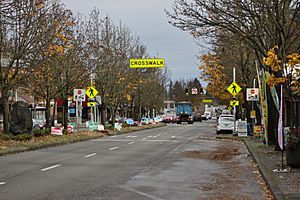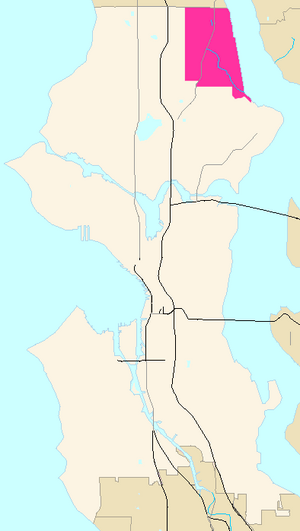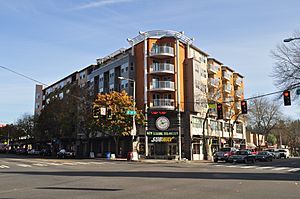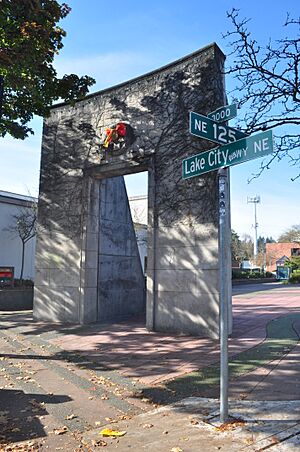Lake City, Seattle facts for kids
Quick facts for kids
Lake City, Seattle
|
|
|---|---|
|
Seattle Neighborhood
|
|

Looking southbound on State Route 522 (Lake City Way) from NE 123rd Street.
|
|

Lake City Highlighted in Pink
|
|
| Country | United States |
| State | Washington |
| County | King |
| City | Seattle |
| Zip Code |
98125
|
| Area Code | 206 |
Lake City is a neighborhood located in the northeast part of Seattle, Washington. It's about 7 to 8 miles (11–13 km) northeast of Downtown Seattle. The main street running through it is Lake City Way NE, also known as SR-522.
The area called Lake City is quite large. It stretches from 15th Avenue NE to Lake Washington. Its northern border is NE 145th Street, which is also the Seattle city limit. Lake City is also home to a big part of the Thornton Creek watershed. People in the community and city workers have been working hard to restore this area. They want to make the natural environment better for everyone living in Lake City.
Contents
The History of Lake City
Early Inhabitants and Land Use
People have lived in the area that is now Lake City for a very long time. This goes back to the end of the last Ice Age, about 8,000 BCE. The hah-chu-ahbsh (Lake People), who are now part of the Duwamish tribe, lived here. They were a Coast Salish group speaking Lushootseed.
These people lived in small, permanent villages along the shore of Lake Washington. In the summer, they would spread out. In winter, they lived in large cedar long houses. Each long house was home to many members of an extended family. Sadly, the lake people lost their rights to the land in 1854.
From the 1850s to the early 1900s, the Lake City area was cleared of trees. This was done using simple wagon roads or by transporting logs on Lake Washington. The arrival of the Seattle, Lake Shore and Eastern Railway around 1886 made it even easier. This railway ran along what is now the Burke–Gilman Trail next to the lake. During this time, many wetlands were also drained. In the 1870s, a small German immigrant farming community grew up where Nathan Hale High School now stands.
How Lake City Got Its Name
The Seattle, Lake Shore and Eastern Railway had a passenger stop near where NE 115th Street is today. It was simply called "Lake." In 1906, D.H. and R.H. Lee bought and planned out the land. They decided to name the area Lake City.
When automobiles became popular, Lake City grew differently from older Seattle neighborhoods. Instead of growing around trolley stops, it developed along major roads. The road to Bothell and Everett was paved with brick in 1918. Then, it was paved with asphalt in 1928. This connection to automobiles shaped how Lake City grew and what it felt like. For many years after World War II, Lake City remained a quiet, suburban area, somewhat separate from Seattle.
Becoming a Community
Lake City started to feel more like a neighborhood community in 1935. This is when the Lake City Branch Library began. It started as just a few shelves of books in a room at Lake City School. The WPA also shared this space. A local group called the Pacific Improvement Club helped support the library.
In 1949, Lake City officially became a township. It had more than 40,000 residents. This fast growth happened because many young families moved to the suburbs after World War II. In 1954, the City of Seattle made Lake City part of the city. This happened when Seattle's city limits expanded from 85th Street to 145th Street. In 1955, Scout Troop 240 and other volunteers helped move thousands of books into a new library building.
Business and Growth
Lake City's economy relies a lot on stores and businesses. How well these businesses did often depended on new highway projects in the Seattle area. In the 1920s, business slowed down when Aurora Avenue North was extended to Everett, Washington. But Lake City bounced back after NE 130th Street was paved.
The opening of Northgate Mall in 1950 caused a drop in retail business in Lake City. The area faced another challenge when Interstate 5 was built in the 1960s. However, improvements to the main part of the city along Lake City Way NE, near NE 125th Street, helped the local economy recover in the late 1970s.
Lake City Today
In 2006, the Lake City branch of the Seattle Public Library was rebuilt and reopened. It continues to serve the community.
Neighborhoods within Lake City
Lake City includes several smaller neighborhoods:
- Cedar Park
- Matthews Beach
- Meadowbrook
- Olympic Hills
- Victory Heights




